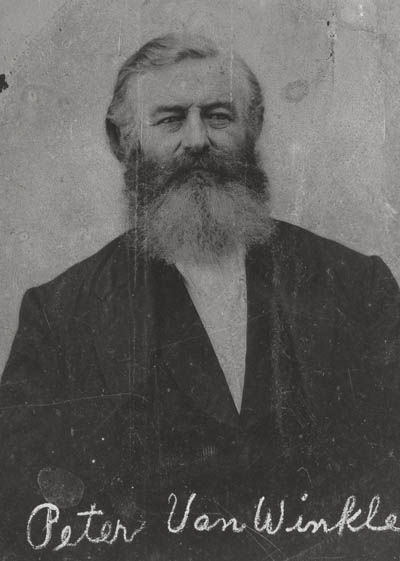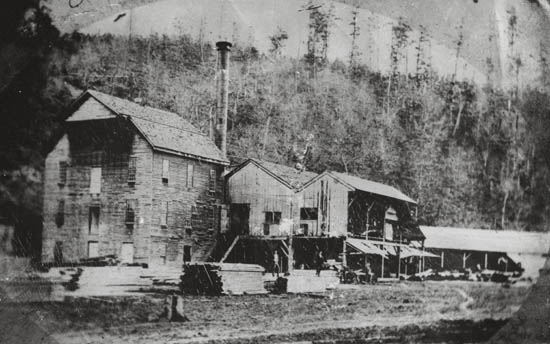Peter Van Winkle

Chapters
Peter Van WinkleImage courtesy of Private Collector
Peter Marselis Van Winkle was born in New York City on February 25, 1814 and was the fourth child of Helmich and Antje Van Winkle. At a young age, Peter moved with his family to Franklin County, Illinois. Peter had already been married twice by his 26th birthday. He first married Ellenora Wilcoxen in Fulton County, Illinois on December 21, 1837, but she died shortly after. Peter then married Temperance Miller on May 3, 1840. Peter combined his pioneering spirit and his entrepreneurial abilities to begin a life in the Western Frontier.
In 1838, Peter purchased 80 acres of land in Washington County, Arkansas at $1.50 per acre.1 There, Peter and Temperance established a farm three miles outside of Fayetteville. Peter embarked on new business ventures to increase revenue and embracing new technology to enhance productivity. By 1850, he constructed a wagon shop, where he outfitted wagons with a spring system he invented to make the journey more bearable for riders travelling over rough terrain. The invention was popular among settlers headed west. Peter also designed a new type of plow that could be pulled by several oxen. The new plow enhanced tilling of the heavy prairie sod of the region, and was widely used across northern Arkansas.2
By 1851, Peter, Temperance, and their five children moved to Benton County, where they built a sawmill in the middle of a dense forest, which supplied Peter with his lumber. The mill was powered by oxen, which were shod to protect their feet. Peter then designed a specialty wagon to haul heavy logs to the mill. The timber was suspended beneath the carriage and drug by teams of oxen. His mill approximately one mile east of the area known as Van Winkle ferry. Peter built the ferry and he waved the 50 cent fee for any of his lumber customers.3 By 1858, Peter’s mill business boomed, and he decided to expand his operation and build a new mill in present day Van Winkle Hollow.
The demand for Peter’s lumber grew, as northern Arkansas developed, and it became clear to Peter that he needed to increase his mill’s productivity and distribution. He hired an engineer from Baltimore to construct steam engines to power the new mill. His steam powered mill was more efficient than his previous, and freed the livestock to haul in timber. With a more efficient mill and higher demand for lumber, Peter needed to increase his supply of raw timber so he designed new wagons to carry heaver loads. Teams of six or twelve oxen could pull each wagon, and they hauled timber from across northwest Arkansas and southwest Missouri to the mill. Peter also built an extensive road network stretching across northern Arkansas and into Missouri to expedite the transportation of timber.
Peter was not only a conscience businessman, but also a loving and devoted father.
He hired Martin Walker, who lived near him in Washington County, to teach his children and others in the area. Education was important to Peter, and he wanted to make sure his children had every opportunity possible. Martin eventually fell in love with and married Ann Van Winkle, Peter’s daughter.
By 1860, the Van Winkle homestead had grown very steadily. The family lived in a plantation style home with eight children and three apprentices. John Bell Steele, from Tennessee, was a lathe apprentice and lived in the Van Winkle home, where he fell in love with Peter’s daughter, Mary. Peter acquired additional land in Benton, Carroll, Madison and Washington Counties. He also purchased land in Missouri. His 1861 tax records value his estate at $42,772, including 12 slaves and 1,370 acres in Benton County.4
The Civil War brought business and hardships to the Van Winkles’ doorstep. In 1862, Peter held contracts with the Confederate States of America to build cabins for General Benjamin McCullough’s men at Cross Hollows. The encampment at Cross Hallows was only 18 miles from the Missouri State border which allowed McCullough to protect the valuable resources of Northwest Arkansas and monitor the events in Missouri. These winter quarters included 39 buildings for the men and five stables for horses. The invoice totaled $20,920. In February 1862, Federal forces marched into Northern Arkansas pursuing General Sterling Price’s retreat from Springfield, MO. McCullough’s men evacuated their winter quarters to obtain supplies in Fayetteville before engaging the approaching Union forces, which resulted in the Battle of Pea Ridge on March 7th and 8th. McCullough had his men destroy the quarters at Cross Hollows, to prevent Union men from commandeering the facilities.
After the Union victory at Pea Ridge, Confederate forces were sent east of the Mississippi River to Tennessee, which left Northwest Arkansas in the hands of the Union. Family stories recount federal troops forcing their way into the Van Winkle home, slashing the walls with their sabers, breaking windows, and threatening to burn the home, mill, and surrounding buildings to the ground. Peter took his family and slaves to Texas, settling in DeKalb, Bowie County. Martin Walker enlisted for service in the war, while Ann joined her father and family on their journey to Texas. Temperance was pregnant with their ninth child, Robert E. Lee, during the journey, and Ann gave birth to her third child in Texas. Apparently, Ann returned home before 1864, as her youngest daughter recounts watching Union soldiers pillage their old home and burn it to the ground. Other reports indicate that bushwhackers or Confederates burned the Van Winkle homestead to prevent Union Troops from taking control of the mill and buildings.
Van Winkle MillImage courtesy of the Shiloh Museum of Ozark History
After the war ended Reconstruction in Arkansas was difficult and slow. The price of land and cost of living was inexpensive, but the availability of money in the region was scarce. Peter returned to Arkansas in 1866 with plans to rebuild his mill and the region. He requested boilers from the east coast which were shipped to St. Louis and then down the Mississippi to Van Buren, Arkansas. Three, twenty-four foot long and four foot round, boilers were transported over the Boston Mountains by ox and cart to Van Winkle Hollow.5 The three boilers supplied 200 horsepower to the mill’s engine. The flywheel, twenty feet in diameter and weighing 20,000 lbs, was transported to Rolla by train, and then by ox and cart to the Hollow. Twelve mules pulled the wagon. Peter also built a sash and window facility on his property, and soon the Van Winkle Hollow was producing nearly every supply required to construct a home or building. Later a grist mill was added to the property, rounding out the agricultural production in Van Winkle Hollow. In 1889, Goodspeed’s inventory of Van Winkle Mills included: one circular saw, two planers, three cut-off saws, two rip saws, one resawing machine for beveled siding, one shingle machine, one scroll saw, two molding machines, one tenoning machine, one mortising machine, and one automatic emery wheel for grinding planer pits, one iron lathe and one wood lathe.6
In 1870, Peter began building a new home. Peter and his extended family all listed Cross Hollows as their home in the 1870 census. Construction for the house was well underway in 1871, and the new home had two stories with eleven rooms and three large fireplaces. The bricks for the fireplaces were made by the freed slaves who chose to return with the Van Winkles and work at the mill. With Van Winkle’s fortune nearly gone he told his former slaves that they should take their freedom and go elsewhere to make a living since he could not afford to pay them, but many chose to stay and remained loyal employees for years to come.7
Peter was instrumental in the rebuilding of Arkansas. He was known to have donated lumber and other supplies to help with the reconstruction and even drafted building plans. He expanded his property to include mills in Madison and Carroll Counties. Peter assisted with the development of churches, schools, road network and railroad across northwest Arkansas. Peter supplied lumber for the construction of the “Old Main” building on the University campus in Fayetteville. The University opened its doors on January 22, 1872. Many of the public buildings in surrounding towns, such as the courthouse in Bentonville were built with lumber from Van Winkle Mills. Peter’s lumber traveled into Missouri and Kansas as well, supplying steady streams of goods for families rebuilding their lives.
Peter died on February 10, 1882 in Rodgers, Arkansas. He was on a walk with his wife and son, Peter Jr., when he suddenly died and dropped in the street. The Fayetteville Democrat reported that they have never seen as many people attend a funeral to pay their respects “to a departed friend and honored citizen.”8 The family continued to run the Van Winkle Mill, as it had when Peter “retired.” In many ways Peter Van Winkle may have single handedly shaped the development of the Ozarks, and rejuvenated the region as the country attempted to reconstruct civilization after the Civil War.
Contributed by the Roger’s Historical Museum, Shiloh Museum of Ozark History, and private collector
- Marilyn Larner Hicks, The Van Winkle Family: Peter Marselis Van Winkle 1814-1882 (Wolfe City, TX: Henington Publishing Company, 1990), 17.
- Hicks, The Van Winkle Family, 17.
- Hicks, The Van Winkle Family, 20.
- Hicks, The Van Winkle Family, 21.
- Hicks, The Van Winkle Family, 25.
- Benton County Section of Goodspeed’s Benton, Washington, Carroll, Madison, Crawford, Franklin and Sebastion Counties Arkansas.(Bentonville, AR: Benton County Historical Society, 2000), 107-108, http://www.projectpast.org/vanwinkle/pubs/abv2006/Appendix%20E.pdf
- Hicks, The Van Winkle Family, 51.
- Fayetteville Democrat [Fayetteville, Ark.], Feb. 16, 1882, http://www.jstor.org/pss/40038103.
















